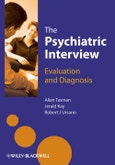The patient interview is at the heart of psychiatric practice. Listening and interviewing skills are the primary tools the psychiatrist uses to obtain the information needed to make an accurate diagnosis and then to plan appropriate treatment. The American Board of Psychiatry and Neurology and the Accrediting Council on Graduate Medical Education identify interviewing skills as a core competency for psychiatric residents.
The Psychiatric Interview: Evaluation and Diagnosis is a new and modern approach to this topic that fulfils the need for training in biopsychosocial assessment and diagnosis. It makes use of both classical and new knowledge of psychiatric diagnosis, assessment, treatment planning, and doctor–patient collaboration. Written by world leaders in education, the book is based on the acclaimed Psychiatry, Third Edition, by Tasman and Kay et al., with new chapters to address assessment in special populations and formulation. The psychiatric interview is conceptualized as integrating the patient’s experience with psychological, biological, and environmental components of the illness.
This is an excellent new text for psychiatry residents at all stages of their training. It is also useful for medical students interested in psychiatry and for practicing psychiatrists who may wish to refresh their interviewing skills.
Table of Contents
Contributors ix
Preface xi
Acknowledgments xiii
Chapter 1 Listening to the Patient 1
Listening: The Key Skill in Psychiatry 1
The Primary Tools: Words, Analogies, Metaphors, Similes, and Symbols 3
How Does One Hear Words in This Way? 4
Listening as More Than Hearing 6
Common Blocks to Effective Listening 7
Crucial Attitudes That Enable Effective Listening 10
Theoretical Perspectives on Listening 14
Using Oneself in Listening 16
To Be Found: The Psychological Product of Being Heard 18
Listening to Oneself to Listen Better 20
Listening in Special Clinical Situations 23
Growing and Maturing as a Listener 26
Chapter 2 Physician–Patient Relationship 31
Formation of the Physician–Patient Relationship 34
Special Issues in the Physician–Patient Relationship 42
The Physician–Patient Relationship in Specific Populations of Patients 44
Conclusion 46
Chapter 3 The Cultural Context of Clinical Assessment 47
Introduction: The Cultural Matrix of Psychiatry 47
What Is Culture? 48
Culture and Gender 50
The Cultural Formulation 51
Ethnocultural Identity 52
Illness Explanations and Help-Seeking 53
Psychosocial Environment and Levels of Functioning 55
Clinician–Patient Relationship 56
Overall Assessment 57
Cultural Competence 57
Working with Interpreters and Culture-Brokers 60
Conclusion: The Limits of Culture 62
Chapter 4 The Psychiatric Interview: Settings and Techniques 65
Goals of the Psychiatric Interview 66
The Psychiatric Database 75
Database Components 77
Mental Status Examination 81
Conduct of the Interview: Factors That Affect the Interview 83
General Features of Psychiatric Interviews 85
Chapter 5 Psychiatric Interviews: Special Populations 103
Randon Welton and Jerald Kay
Psychiatric Interview in Special Circumstances 104
Psychiatric Interview in Special Patient Populations 115
Conclusions 131
Chapter 6 Formulation 135
Allison Cowan, Randon Welton and Jerald Kay
Biological Contributions 136
Social Factors 138
Psychological Factors 140
Summary 146
Chapter 7 Clinical Evaluation and Treatment Planning: A Multimodal Approach 147
Psychiatric Interview 147
Identifying Information 149
Chief Complaint 149
History of Present Illness 150
Past Psychiatric History 150
Personal History 150
Family History 151
Medical History 152
Substance Use History 152
Mental Status Examination 153
Physical Examination 157
Neurological Examination 158
Psychological and Neuropsychological Testing 159
Structured Clinical Instruments and Rating Scales 159
Laboratory Assessments 159
Neurophysiologic Assessment 159
Brain Imaging 162
Special Assessment Techniques 163
Assessment of Risk 164
Suicide Risk 164
Differential Diagnosis 167
Initial Treatment Plan 170
Conclusion 171
Chapter 8 Professional Ethics and Boundaries 173
Introduction 173
Ethical Behavior and Its Relationship to the Professional Attitude 174
WPA Guidelines on Euthanasia 176
WPA Guidelines on Torture 177
WPA Guidelines on Sex Selection 177
WPA Guidelines on Organ Transplantation 177
WPA Guidelines on Genetic Research and Counseling in Psychiatric Patients 177
WPA Guidelines on Ethnic Discrimination and Ethnic Cleansing 178
WPA Guidelines on Psychiatrists Addressing the Media 178
The Coherent Treatment Frame and the Role of Therapeutic Boundaries in Effective Psychiatric Treatment 178
Boundary Violations 179
Components of the Coherent Psychiatric Frame 180
Stability 181
Avoiding Dual Relationships 182
Autonomy and Neutrality 183
Coherent and Noncollusive Compensation 183
Confidentiality 184
Anonymity 184
Abstinence 185
Self-respect and Self-protection 186
Summary 187
Index 191








